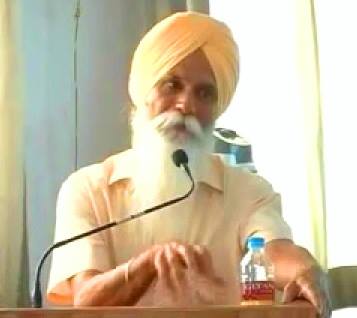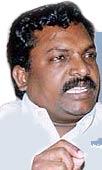Sardar Ajmer Singh
This article is an excerpt from S. Ajmer Singh’s book “Biswi Sadi Ki Sikh Rajneeti: Ek Ghulami Se Dusri Ghulami Tak” (The Sikh Politics of the 20th Century: From One Slavery to Another)

On the circumstances emerging after the partition of Punjab, and the creation of a Self-ruled Sikh state
After the partition of India, there was a significant shuffling of the various classes in proportion to the overall population in East Punjab. The Hindus and Sikhs of Western Punjab and the northwestern border areas were forced to leave their homes and cross the border into the newly formed Indian state. And from this side of the border, the Muslim population of Eastern Punjab moved en masse to West Punjab. The displaced or uprooted Sikh families from Lyallpur, Mintgumri and Sheikhupura came and settled in their ancestral villages in the Jalandhar division. A large part of the displaced Hindu population from Pakistan went and settled in the areas lying on the other side of the river Ghaggar. This shuffling or change in the population severely affected the relations between both the Hindu and Sikh communities. In the total population of East Punjab which stood at 1 crore 25 lakhs, the population of the Hindus reached about 62 percent and the Sikhs about 35 per cent. In this manner, for the first time in the history, the Hindus became a majority in Punjab. Similarly, for the first time in history the Sikh brotherhood achieved a majority in a united area (the areas between the rivers Ravi and Ghaggar).
There is no doubt that the Sikh community suffered a lot, both in terms of lives lost and material losses as a result of the partition of Punjab, but the political avenues that this catastrophe opened up for the Sikh community, is something only an astute mind like Dr. Ambedkar’s could properly assess. In February 1948, when a deputation of Sikhs apprised Dr. Ambedkar of the difficulties being faced by the Sikh community due to partition, his researched and prescient reply* was:
“Your population in the united Punjab was about 13 per cent. In this manner, though you were more united, yet as a minority you were at the mercy of Hindus and Muslims. Despite your inherent power, agility, hard work and labour, you kept striving to reach somewhere close to these two communities larger in number than yours. But in terms of political power, you had next to nothing on your side. The partition of India was most certainly very tragic, where apart from huge material losses, the people had to suffer all sorts of difficulties.
But this partition, albeit forced, has certainly benefited your Sikh community politically and it will continue to benefit you in economic terms in the coming times. From what I hear and see, your community has gained majority in the six riyasats spanning about 12000 sq. kms. You will have a majority in all 6 districts of the Jalandhar division. This way, once this forced transfer of power is over, you will have managed to achieve a majority in an area of about 50000 sq. kms.

In the 400 year long history of your community, it would be for the first time that you will have a homeland that you can call your own. You have a religion that binds you to each other; from all the measures of a community, you have now a home and you still tell me that you have suffered huge losses. History has shown that one has to suffer a lot to achieve something like this. Now that you have a geographical region that you can call your own, where as per the right time and circumstances, invoking the right to self rule you can decide to separate, then how long can any group in India suppress you or treat you in a bad way?”
This insight by Dr. Ambedkar makes three things amply clear. First, he saw the Sikh community not just as a religious minority, but as a community “according to all the parameters that define a shared community”.
Second, he considered the right to self-determination as an inalienable right of each community. He had a conviction that according to the rules of self-determination, each and every community had the right to declare its independence as and when the time and circumstances arise.
Third, after achieving a majority in a united geography of the Sikhs, he envisaged and anticipated an independent future for the Sikh community in that region.
If one looks at it from the perspective of Dr. Ambedkar, the partition of 1947 could have proved to be a boon for the Sikh community, provided the Sikhs were willing and conscious of the same. The practical hurdles that the Sikh community was facing on its way to freedom in the undivided Punjab were automatically removed with the partition.
But as we have already discussed that the major difficulty for the Sikh Community in undivided Punjab wasn’t about practical matters but about an ideological weakness on part of the Sikh leadership. But even after the partition, this weakness of the Sikh leadership persisted. Their approach to the Sikh issue was fundamentally different from that of Dr. Ambedkar’s. Though they would refer to a Sikh qaum but for all practical purposes they considered the Sikh panth as a religious minority group. Their main aim was to fight for and protect the rights and interests of the Sikh community as a religious minority within the independent Indian nation state.
As found among the common Sikh populace, there were some sections among the Sikh leadership who were zealous and eager to fight for freedom of the Sikh community, but there was an overall lack of ideological clarity and sharp decision-making among them. Given this lack of consciousness as a distinct community, they became victims to a perspective of imagining themselves as a minority instead of fighting for the rights and interests of the Sikhs as a separate community. Because of the huge gap between passion and a political consciousness, they kept making noises and their positions kept wavering.
If there was anyone who was most affected by this ideological disease, it was Master Tara Singh. If one looks at his long career spanning six decades and sees his different political manoeuvrings at various points as well as taking into account his speeches etc., it becomes quite evident that his passion and his politics were often at odds with each other. Among all his contemporary ‘nationalist’ Sikh leaders, he was the only one whose heart kept yearning for freedom for the Sikhs, but his ‘mind’ kept refusing to follow his heart. The following quote by him during India’s struggle for freedom in 1937-38, brings out this contradiction quite clearly:
“I certainly want a Sikh state and I’m also in favour of self rule or shared statehood. But I am not such a fool that I don’t realize the impossibility of a Sikh state. […] There is only a possibility of Indian rule or a shared state. That is what we should wish and work towards.”
It is quite clear that Tara Singh desired freedom for the Sikhs, from the bottom of his heart. This however alienated him from other ‘nationalist’ Sikh leaders who didn’t wish for freedom for the Sikh community, and who considered themselves a part of the larger Hindu stream. As Master ji didn’t see the scope of freedom for the Sikh community due to his inner ideological conflict, his common sense perhaps stopped him from walking that road.
Even after 1947 he was torn with this inner conflict. When in a moment of passion, he would speak his heart out; it would hugely discomfort the Hindu leaders. Due to lack of ideological clarity, each time he faced such attacks from the Hinduvadis, Master Tara Singh would go on the back foot and get defensive. With all this he would already feel defeated inside and then also face further ignominy in the eyes of his Sikh comrades. These repeated insults created a lot of psychological complications in his personality. Because of which he faced much scrutiny from strangers as well as a lot of complaints and taunts from his own people.
* Excerpted from Ajit Singh Sarhadi, Punjab Suba: The Story Of Struggles, (1970), pp. 146-47
Translated by Gurinder Azad and Akshay Pathak.
~~~
Sardar Ajmer Singh is a well-known historian in Punjab. He supports a separate Sikh state. His books on the brahminical attacks on the Sikh panths are sources of immense inspiration and value. He has written extensively on the establishment of the Sikh panth, the brahmincal attacks on the same as well as the statist and non-governmental attempts at appropriating the Sikh panth.









